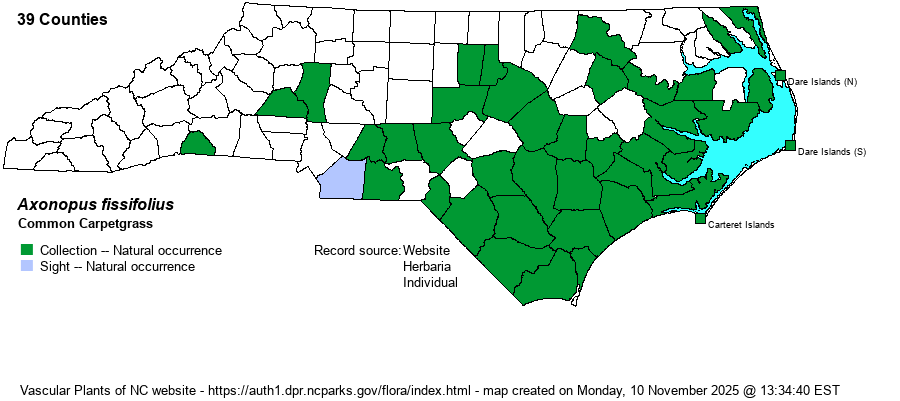| Author | (Raddi) Kuhlmann | |
| Distribution | Mostly Coastal Plain, including the Outer Banks/barrier islands; also scattered in the Sandhills and Piedmont. Absent from the Mountains.
Coastal Plain and Piedmont, southeastern VA to southern FL, southeastern TX, and northern AR. | |
| Abundance | Frequent on the landscape in the Coastal Plain; uncommon westward in the Piedmont to Catawba and Polk counties. Absent in the Mountains and probably in much of the northwestern Piedmont. | |
| Habitat | Dry roadsides, lawns, fields, sandy woodlands, openings in maritime forests. | |
| Phenology | Flowering and fruiting June-October. | |
| Identification | Common Carpetgrass is more-or-less mat-forming from slender horizontal rhizomes. The slender stems grow erect, 1-2 feet tall (where not mown), topped by an inflorescence of 2 ascending to spreading, slender branches, with spikelets tightly pressed to the branches. Sometimes also it has an additional inflorescence from a leaf axil lower down on the stem. Axonopus furcatus is very similar but it has spikelets that are 3.5-5.5 mm long (vs. 1.6-2.8 mm long in A. fissifolius). Note that Bryan England has collected plants in several places in Wake County that have leaves wider than normal, as much as 8 mm wide, and which approach A. compressus leaf width (1.0 mm or more). These plants are otherwise just like A. fissifolius and not to be confused with the subtropical/tropical A. compressus, which has not been found north of central SC. | |
| Taxonomic Comments | A synonym is A. affinis Chase.
| |
| Other Common Name(s) | Narrowleaf Carpetgrass, Caratao Grass, Louisiana Grass | |
| State Rank | S4? [S4] | |
| Global Rank | G5 | |
| State Status | | |
| US Status | | |
| USACE-agcp | FACW link |
| USACE-emp | FACW link |

